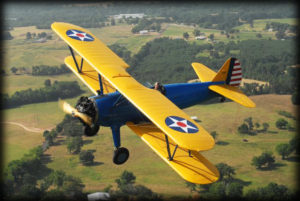Project Description

MPH
SEATS
Stearman
Role: Biplane Trainer
National Origin: United States
Manufacturer: Stearman Aircraft / Boeing
First Flight: 1934
Primary User: US Army, US Air Force, US Navy, Royal Canadian Air Force, Civilian Market
Number Built: 10,620+
The Stearman (Boeing) Model 75 is a biplane used as a military trainer aircraft, of which at least 10,626 were built in the United States during the 1930s and 1940s. Stearman Aircraft became a subsidiary of Boeing in 1934. Widely known as the Stearman, Boeing Stearman or Kaydet, it served as a primary trainer for the United States Army Air Forces, the United States Navy (as the NS & N2S), and with the Royal Canadian Air Force as the Kaydet throughout World War II. After the conflict was over, thousands of surplus aircraft were sold on the civilian market. In the immediate postwar years they became popular as crop dusters, sports planes, and for aerobatic and wing walking use in air shows.
The Kaydet was a conventional biplane of rugged construction with large, fixed tailwheel undercarriage, and accommodation for the student and instructor in open cockpits in tandem. The radial engine was usually uncowled, although some Stearman operators choose to cowl the engine, most notably the Red Baron Stearman Squadron.
After World War II, the thousands of primary trainer PT-17 Stearman planes were auctioned off to civilians and former pilots. Many were modified for cropdusting use, with a hopper for pesticide or fertilizer fitted in place of the front cockpit. Additional equipment included pumps, spray bars, and nozzles mounted below the lower wings. A popular approved modification to increase the maximum takeoff weight and climb performance involved fitting a larger Pratt & Whitney R-985 Wasp Junior engine and a constant-speed propeller. An iconic movie image is a Stearman cropduster chasing Cary Grant across a field in North by Northwest (the airplane that chased Grant was actually a Naval Aircraft Factory N3N Canary; the plane that hits the truck is a Stearman). Christopher Reeve and Scott Wilson are shown flying 1936 variants in the 1985 movie The Aviator.
General characteristics
- Crew: two, student and instructor
- Length: 24 ft 9 in (7.54 m)
- Wingspan: 32 ft 2 in (9.81 m)
- Height: 9 ft 8 in (3 m)
- Wing area: 298 sq ft (27.7 m²)
- Empty weight: 1,931 lb (878 kg)
- Max. takeoff weight: 2,635 lb (1,200 kg)
- Powerplant: 1 × Continental R-670-5 seven-cylinder air-cooled radial engine, 220 hp (164 kW)
Performance
- Maximum speed: 135 mph (117 knots, 217 km/h)
- Cruise speed: 96 mph (83 knots, 155 km/h)
- Service ceiling: 13,200 ft (4,024 m)
- Climb to 10,000 ft (3,330 m): 17.3 min